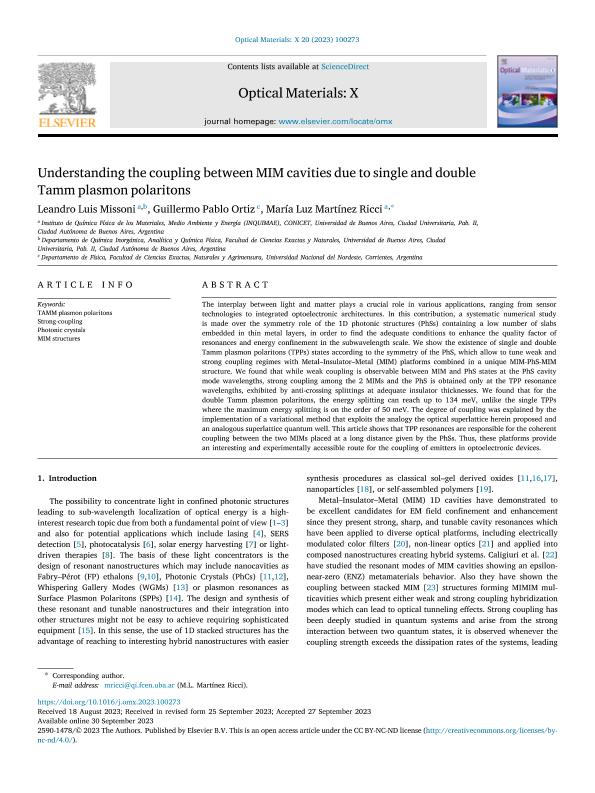Mostrar el registro sencillo del ítem
dc.contributor.author
Missoni, Leandro Luis

dc.contributor.author
Ortiz, Guillermo Pablo

dc.contributor.author
Martinez Ricci, Maria Luz

dc.date.available
2024-02-26T12:56:37Z
dc.date.issued
2023-12
dc.identifier.citation
Missoni, Leandro Luis; Ortiz, Guillermo Pablo; Martinez Ricci, Maria Luz; Understanding the coupling between MIM cavities due to single and double Tamm plasmon polaritons; Elsevier; Optical Materials: X; 20; 12-2023; 1-9
dc.identifier.issn
2590-1478
dc.identifier.uri
http://hdl.handle.net/11336/228357
dc.description.abstract
The interplay between light and matter plays a crucial role in various applications, ranging from sensor technologies to integrated optoelectronic architectures. In this contribution, a systematic numerical study is made over the symmetry role of the 1D photonic structures (PhSs) containing a low number of slabs embedded in thin metal layers, in order to find the adequate conditions to enhance the quality factor of resonances and energy confinement in the subwavelength scale. We show the existence of single and double Tamm plasmon polaritons (TPPs) states according to the symmetry of the PhS, which allow to tune weak and strong coupling regimes with Metal–Insulator–Metal (MIM) platforms combined in a unique MIM-PhS-MIM structure. We found that while weak coupling is observable between MIM and PhS states at the PhS cavity mode wavelengths, strong coupling among the 2 MIMs and the PhS is obtained only at the TPP resonance wavelengths, exhibited by anti-crossing splittings at adequate insulator thicknesses. We found that for the double Tamm plasmon polaritons, the energy splitting can reach up to 134 meV, unlike the single TPPs where the maximum energy splitting is on the order of 50 meV. The degree of coupling was explained by the implementation of a variational method that exploits the analogy the optical superlattice herein proposed and an analogous superlattice quantum well. This article shows that TPP resonances are responsible for the coherent coupling between the two MIMs placed at a long distance given by the PhSs. Thus, these platforms provide an interesting and experimentally accessible route for the coupling of emitters in optoelectronic devices.
dc.format
application/pdf
dc.language.iso
eng
dc.publisher
Elsevier

dc.rights
info:eu-repo/semantics/openAccess
dc.rights.uri
https://creativecommons.org/licenses/by-nc-nd/2.5/ar/
dc.subject
MIM STRUCTURES
dc.subject
PHOTONIC CRYSTALS
dc.subject
STRONG-COUPLING
dc.subject
TAMM PLASMON POLARITONS
dc.subject.classification
Óptica

dc.subject.classification
Ciencias Físicas

dc.subject.classification
CIENCIAS NATURALES Y EXACTAS

dc.title
Understanding the coupling between MIM cavities due to single and double Tamm plasmon polaritons
dc.type
info:eu-repo/semantics/article
dc.type
info:ar-repo/semantics/artículo
dc.type
info:eu-repo/semantics/publishedVersion
dc.date.updated
2024-02-26T10:55:24Z
dc.journal.volume
20
dc.journal.pagination
1-9
dc.journal.pais
Argentina

dc.description.fil
Fil: Missoni, Leandro Luis. Consejo Nacional de Investigaciones Científicas y Técnicas. Oficina de Coordinación Administrativa Ciudad Universitaria. Instituto de Química, Física de los Materiales, Medioambiente y Energía. Universidad de Buenos Aires. Facultad de Ciencias Exactas y Naturales. Instituto de Química, Física de los Materiales, Medioambiente y Energía; Argentina
dc.description.fil
Fil: Ortiz, Guillermo Pablo. Universidad Nacional del Nordeste; Argentina
dc.description.fil
Fil: Martinez Ricci, Maria Luz. Consejo Nacional de Investigaciones Científicas y Técnicas. Oficina de Coordinación Administrativa Ciudad Universitaria. Instituto de Química, Física de los Materiales, Medioambiente y Energía. Universidad de Buenos Aires. Facultad de Ciencias Exactas y Naturales. Instituto de Química, Física de los Materiales, Medioambiente y Energía; Argentina
dc.journal.title
Optical Materials: X
dc.relation.alternativeid
info:eu-repo/semantics/altIdentifier/doi/http://dx.doi.org/10.1016/j.omx.2023.100273
Archivos asociados
